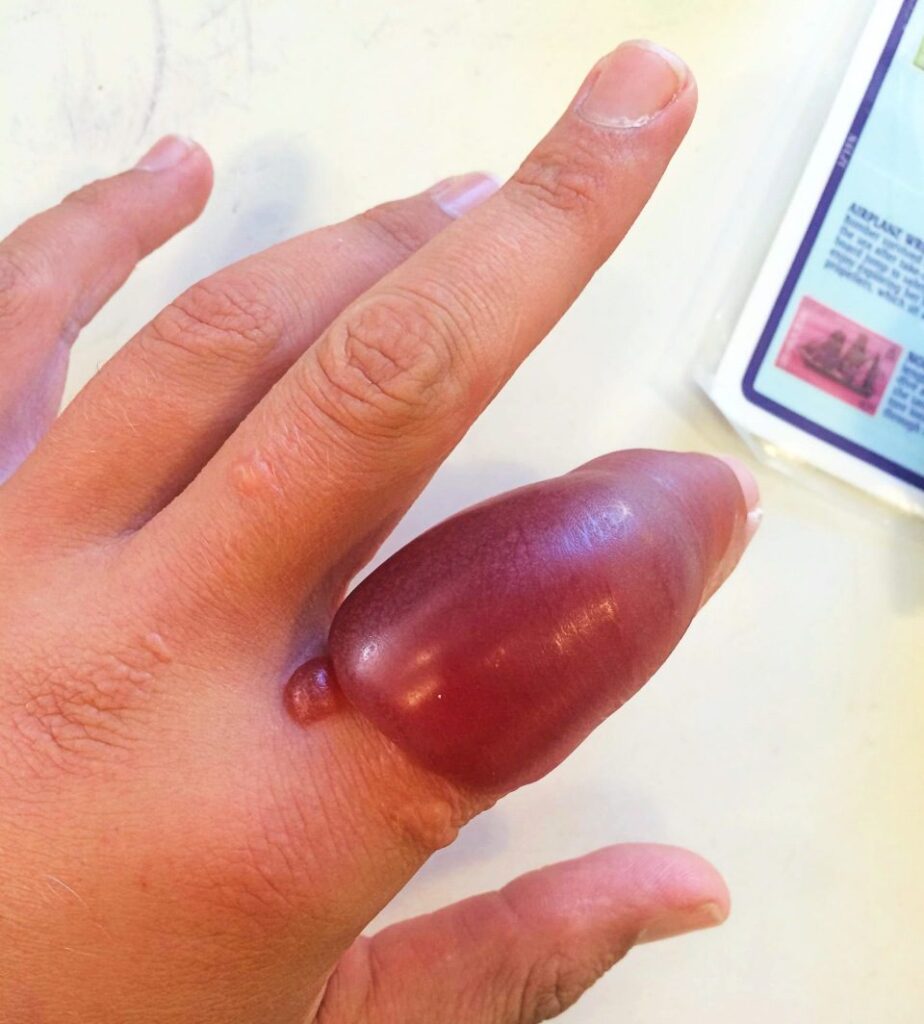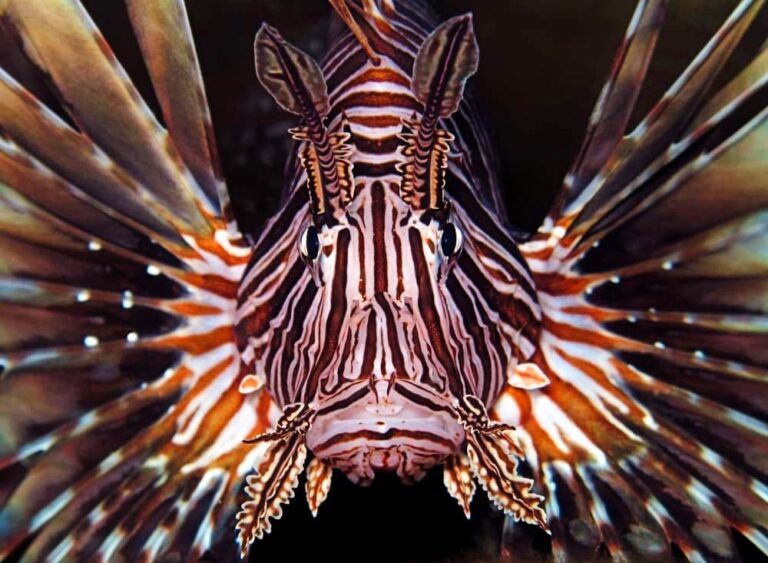In parts of the world divers are waging a hard-to-win battle against invasive lionfish – but when these fish strike back, it can be to devastating effect. PENELOPE GRANYCOME reports
Healthy ecosystems are built on natural interdependency and a species knowing its place, so it’s no surprise that the species that doesn’t conform is the one that wreaks the most havoc.
That victim of human interference, the beautiful, spiky lionfish, is now an invasive species in the Western Atlantic, Caribbean and Mediterranean. PADI regional training consultant Matt Noel was not to be turned against them, however – even after an unfortunate underwater encounter that sent shockwaves of pain through his body and swelled one of his fingers to the size of a giant slug (below).

The genus Pterois comprises 12 species of lionfish, with their spectacular peacock plumes of 18 spines. Get too close to this member of the venomous Scorpaenidae family and a brush with just one of those spines can inflict severe problems.
Pterois volitans and Pterois miles are the most studied species. P volitans, the red lionfish, is also the most pervasive. Its natural home is the Indo-Pacific, where it has evolved alongside natural predators that include moray eels, tiger grouper and blue-spotted cornetfish.
From around 1985 it is thought to have been introduced to the east coast of the USA and the Caribbean by aquarium-owners, who gave little thought to the possible impact the fish could have should it be released into the wild. Genetic surveys since then have suggested three introduction scenarios: off North Carolina, off the Bahamas or both.
‘Reproduce like rabbits’
Working as an instructor at a dive-centre in Bermuda from 2013 to 2017, Matt was well aware of this development. As an invasive non-native species, lionfish were already being hunted to keep their numbers down but, as he explains: “Lionfish don’t have an off-switch, and they are incredibly adaptive. They voraciously eat fish crucial to the food-chain and ecosystem – and reproduce like rabbits.”
A female can release up to 2 million eggs a year and, once established on a reef, lionfish can reduce its fish population by as much as 70%. Many of the fish they eat are herbivorous, so their removal means that algae is no longer eaten (other causes of macroalgae flourishing can include overfishing, agricultural run-off and mangrove destruction).
An increase in algae robs coral reefs of the light and space needed for growth, so can severely reduce their effectiveness as the first line of defence against incoming waves and storms. Such deterioration could put 200 million people at risk across more than 80 nations.
The depletion of sharks by humans, whether through intentional hunting or as bycatch, has a similar ripple-down effect with huge consequences. In this case fewer sharks can mean more herbivorous fish. Everything is interconnected, and human interference causes both damaging proliferation and absences in food-chains.
I have seen lionfish speared at close hand, and enjoyed the sublime, omega-3-rich buttery taste of them when expertly prepared. Humans eating them poses no danger of depleting the species, though treating them as a culinary asset can only help to encourage their removal.
At the same time there have been attempts to “train” sharks to eat lionfish while alive which, as Matt points out, simply disrupts two species.
Humans cannot train wild animals to mitigate damage, and the sharks become more likely to associate divers with food, causing interactions to become potentially dangerous. I watched a Caribbean reef shark chow down on a dead lionfish in Turks & Caicos (above) but they clearly have no natural instinct to feed on live ones.
Part of Matt’s role was to learn the techniques of safely hunting lionfish, and to help develop a PADI speciality in teaching visiting divers how to dispose of them, combining ecological theory with the practical techniques of using a Hawaiian sling spear. On the second of two dives, the trainees try to find a lionfish, sometimes needing to go into deeper, cooler water to do so.
Matt’s painful encounter happened in winter, while things were relatively quiet. “I was leading a dive and saw this lionfish on top of a wreck,” he told me. “They are very quick over a short distance, and it disappeared under a piece of sheet metal.
“I grabbed a tail, a little overconfident, a little complacent – and two spikes went straight into my finger.”
Knowing that the defensive venom in these spike glands could cause serious problems, and that he had received an entire dose of venom from two spines, Matt thought: “I’m in trouble now.”
He gathered the other divers and headed straight back to the boat but the pain started on the way. He describes it as “a constant, dull throbbing with an intensity that started to build and build and build”. He handed the dead lionfish up to the captain, “got my divers out – and then the pain hit”.
Cooking the venom
Managing to get the ladders up and lines off with the help of a guest, Matt plunged his finger straight into hot water. “Venom is a protein; the only way to neutralise it is to cook it and denature it,” he says, but as the pain increased to a high level, he started wondering if it would ever stop.
Once back on dry land, Matt went straight to a diving doctor, who described what he saw as “pretty bad”. Matt’s hand and arm were filled up with fluid (rapid oedema) and then blisters started to appear.

There have been no reported deaths from a lionfish sting, according to Divers Alert Network (DAN), but medical attention is crucial, because if the swelling becomes too bad blood flow could be compromised, leading to necrosis.
In Matt’s case this was prevented when a hand surgeon saw him in A&E and lanced the venom-filled blister. The surgeon cut off Matt’s epidermis around the site of the injury: “Raw skin in the air was a new kind of pain!” he says.
Matt says he was in agony for about eight hours but got “really really lucky, and had no lasting damage”. It was two weeks before he next dived, having used colloidal silver cream in the meantime to help soothe the damaged skin.
Big respect
Matt’s encounter highlights how aquatic injuries can require quick thinking – in this case especially in view of his responsibility for bringing his group safely to the surface.
A tech diver was reportedly stung by a lionfish but had to complete 30 minutes of deco through gritted teeth before he could surface and go to hospital, His decision not to make a risky ascent was based on his knowledge of such injuries. As with any diving incident, calm heads prevail when the facts are available.
Lionfish devour everything in their path and, although one of their number caused Matt considerable pain, he still maintains: “I think they are incredible animals, perfectly adapted to their environment. I have a big respect for them.”

PADI Master Scuba Diver Penelope Granycome is a professional actress who learnt to dive in Oahu in 2008. Diving has taken her all over the world but she also enjoys both coastal and inland UK diving. She writes about both diving and well-being.
Also on Divernet: Now Cyprus Has Too Many Fish, Driving North, Diving In The Splendour Of St Lucia


Anyone who grabs a lionfish without the right protection (kevlar gloves or use a tool?!) deserves all they get. I suspect it’s a mistake he’ll only make once.